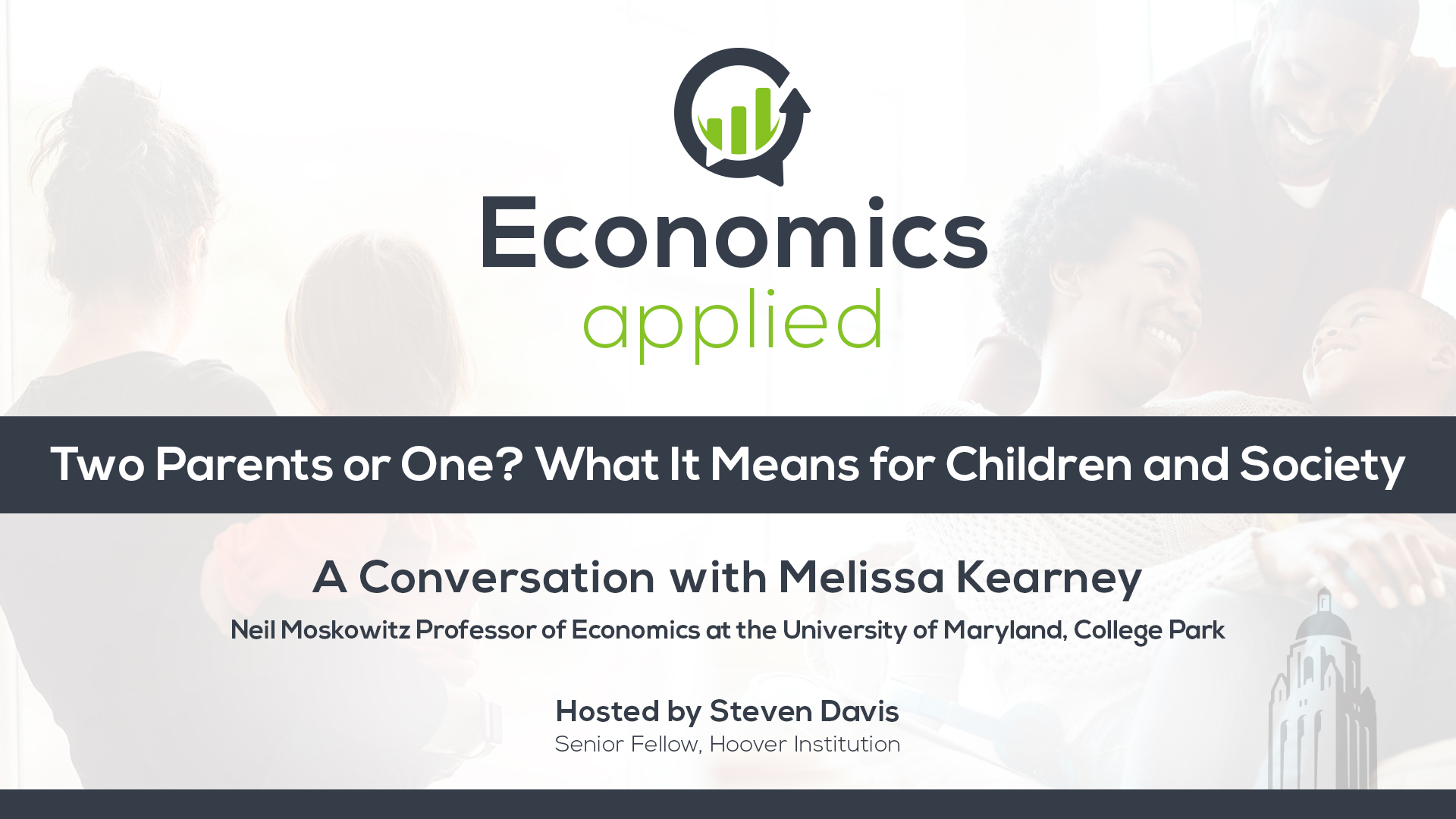It’s easier for two parents to provide the time, attention, love, and financial resources that help children thrive and lead successful lives than it is for a single parent. Yet the share of American children who live with two parents has plummeted in recent decades. The decline is especially steep outside of the college-educated class. Why are so many parents now raising children outside of marriage? What are the consequences for children and society? How do the benefits of two parents play out across racial and ethnic groups? Do the effects differ between boys and girls? What, if anything, can we do so that more children reap the benefits of two-parent households? Tune in, as Melissa Kearney joins Steven Davis to discuss The Two-Parent Privilege, her highly insightful book on these issues.
>> Steven Davis: Two big questions, first, why are so many parents raising children outside of marriage? And second, what are the consequences for the children and for society? Welcome to Economics Applied, a podcast sponsored by the Hoover Institution.
>> Steven Davis: My name is Steven Davis, senior fellow at the Hoover Institution.
Our guest today is Melissa Kearney. She's the Neil Moskowitz professor of economics at the University of Maryland, a highly accomplished researcher, director of the Aspen Economic Strategy Group, and non-resident senior fellow at the Brookings Institution. She's also a mother of three, and I'm sure she's an excellent one.
Welcome to the show, Melissa.
>> Melissa Kearney: Thanks so much for having me, Steve.
>> Steven Davis: So I have my dog-eared copy of your book.
>> Melissa Kearney: I love it. That's awesome, thank you.
>> Steven Davis: The two-parent privileged, how Americans stopped getting married and started falling behind. So this book is scholarly and thoughtful, but also fun to read with clear and lively prose.
So before anything else, congrats on writing such a fine and important book.
>> Melissa Kearney: I appreciate that.
>> Steven Davis: Okay, so set the stage for us, if you would, by summarizing the evidence on how many children now live and grow up with only one parent, how that's changed over time in the United States, and also how the patterns differ across demographic groups.
>> Melissa Kearney: Yeah, great, I like setting the stage with the data here. So, basically, I'm just gonna be citing statistics and answer to your question that come from the US census, so nothing too fancy here.
>> Steven Davis: Okay.
>> Melissa Kearney: But what we see now in census data, is that only 63% of US kids are living with married parents.
And the big story is that that is a huge drop from 1980, so the real decline occurred in the eighties, nineties, early 2000s. Back in 1980, about 77% of kids lived with married parents, now just over 60%. So just that basic fact, I think, surprises a lot of people.
And let me be clear, I'm taking a snapshot from the census. So if I looked at cycling, there would be even more kids who looked like at various points in their childhood they were outside of a two-parent home. Okay, so 63% of kids live in married parent homes.
Importantly, that large decline is not attributed to a huge increase in the number of parents who are just living together in a long term, stable, cohabiting relationship and decided to forego the legality of marriage. Rather, over 20% of US kids live with just an unpartnered mother, their mom doesn't have a spouse or somebody she considers an unmarried parent.
So let me pause on that for a minute, because the share of US kids growing up with only one parent in their home is larger than in any other country for which there's data, 130, 100.
>> Steven Davis: That's stunning.
>> Melissa Kearney: Yeah, so we've got about 21% of kids living with an unpartnered mother, about 4.5% of kids living with an unpartnered father.
About 8% of kids live with what I categorize as cohabiting parents. But what that really is in the census, is they live with one of their biological parents and then the parents other partner. And in about a quarter to 40% of cases, that partner is not the kid's second parent.
So the 8% overstates the share of kids who are living with unmarried of their own parents, and then about 4% of kids live with neither of their biological parents. So the big deal here is, the reason why marriage is so important to this story, is because the decline in marriage among parents over the past four decades means that a very large share of kids are living with only one parent in their home.
About 30% of kids are living outside a two-parent household. Okay, huge divergence across education groups, and this is one of the major themes of my book and one of the major patterns that I'm trying to draw attention to. This decline in parental marriage has really happened outside the college educated class.
So if I just look at kids whose moms have a four-year college degree, the share of them living with married parents has fallen only from 90% to 84%. Wait, that's a really small decline, just six percentage points. Even smaller than you might think when you think about how much larger and more heterogeneous that group of moms has become.
And so, basically, marriage among college educated moms has stayed pretty stable over the past 40 years. I think the real stunning surprise here is that for the middle group of educated moms, moms with a high school degree or some college, that's the majority of moms, their share of their kids who are living in married parent homes, has fallen from about 84% to 60%.
Those kids, or those moms, are now equally likely to be in an unpartnered mother household. It's basically the most disadvantaged group of moms, moms without a high school degree. And so, I think that's what sort of snuck up on a lot of people. Back in the 80s, we knew that there was a larger or rising share of kids born to the most disadvantaged moms, teen moms, moms without a high school degree, living in single mother settings.
That disadvantageous household structure has really spread to a wider share of the population.
>> Steven Davis: Right, so those are really sobering numbers. And I take it from what you said, that we're in somewhat unprecedented territory compared to past US history, but also compared to other countries in the world.
>> Melissa Kearney: Absolutely.
>> Steven Davis: I see, so we'll get into the why part, which I think is, in some respects, maybe the most puzzling. But before we get to the why, we should talk about the consequences.
>> Melissa Kearney: Yeah.
>> Steven Davis: Let me state my version of what I understand to be the two-parent privilege, you can tell me if I basically got it right or not.
So I think it's easier for two parents to devote the time, attention, love and financial resources that help children thrive and become successful as adults, than it is for one parent. And that's not a criticism of single parents, and it doesn't mean that the children of single parents can't succeed.
But it's harder for the parents, it's harder for the children. And on average, in a statistical sense, the outcomes for the children are going to be not as attractive if they only have one parent when they're growing up. I think that proposition is common sense. It also flows, as you make it very clear in your book from basic economic thinking about resources and how you use them and so on.
So if I got it basically right?
>> Melissa Kearney: It's perfect, I love the way you summarized it. And the way you summarized it, as I hear it, you said common sense and also it shouldn't be controversial, right?
>> Steven Davis: Right.
>> Melissa Kearney: So there are times when I'm writing the book where I'm like, this is so trivial to basically point out.
Of course, two parents have more of all kinds of resources, and of course their kids are benefiting from all of those resources, why am I bothering to write this? And then other moments, I'd say, my goodness, this is so controversial to say out loud, do I really wanna say this?
But the way you summarize the argument is exactly right in that it's just reflective. The perspective and the lens that I bring to the issue is just one of resources, and once we Talk about family structure and marriage in that framework. A big part of my hope my goal with this book, was to take it out of the culture wars.
Nobody's blaming the victims here, right? We're sympathetic to the victims, really hard, right? It's really hard, if you are finding yourself in the very hard position of raising kids on your own. There's a lot more you have to do by yourself than someone with a partner. And so then it flows from common sense that that would be harder and there'd be fewer resources for the kids.
But we also have tons and tons of empirical evidence supporting that intuition.
>> Steven Davis: But that's what I was gonna say next. It is common sense, I should say for the audience, that in the circles we travel in, it sometimes takes intellectual courageous to propound the commonsensical.
>> Melissa Kearney: Yeah, yeah.
>> Steven Davis: So I do understand what you're saying about the pushback you get. But while the proposition itself is common sense and I think flows from basic economics. Part of the contribution of your book is to quantify the force of this common sense view. And that does require scholarship and careful assessment of the evidence.
So talk about now, not just in a qualitative sense, but in terms of how much does it matter? For whom does it matter the most? That kind of thing.
>> Melissa Kearney: Yeah, okay, right, so the proposition might be common sense, but you're exactly right. How much or for whom?
That's not so clear. And so one thing I will say, we had lots of studies from the 90s and early 2000 showing that on average, kids who grow up with two parents do better. And a lot of that earlier research really focused on poverty as the outcome. In fact, most research on single parenthood and family structure has focused on poverty.
And so not long ago, maybe eight years ago I started wondering. Given how widespread single motherhood is now, maybe it doesn't matter so much because single moms are more likely to have high school degrees. They're more likely to be older, so they're probably more likely to be able to keep their kid out of poverty, and that is entirely true.
I mean, the heterogeneity or who does it matter for? Actually, there wasn't research on that. So Phil Levine and I wrote down a model of just, how would we think about what we call the marriage premium for kids? Okay? And so the idea is, basically the simple elements of this model is.
It's going to depend on the mom's own level of resources, what the second parent would bring to the household. So you've got a sort of meeting you have, right, higher resource moms partnering with higher resource dads. You also have sort of a reduction in the economic stability of some dads.
So the, the incremental increase in household resources coming from the second parent matters. And then the third element is, how do those total resources combine to produce child outcomes? And once you write down that model, you'll realize, it's gonna matter for different people on different margins. And that's exactly what the data show for kids.
So for the least educated parents, really, the kids are at a disadvantage whether the parents are married or not. They have high rates of poverty, and they're very, very low rates of college attendance. But when you look at parents with a high school degree, whether or not they're married.
Makes a big difference in the likelihood that their child graduates for high school or graduates from a four year college by the age of 25. Surprising to me was, you even see pretty large differences in kids college attainment and adult earnings outcomes. For the children whose moms have a four year college degree by whether or not they're married.
And so this was surprising, right? But, for instance, just unadjusted by all the stuff we adjust in regressions. If you look at college completion rates for kids whose moms have a college degree, it goes from, roughly 25% to 52% based on whether their parents are married or not.
And the way I think about that is, it takes a lot of resources to get a kid through a four year college degree. And in our society, it's really two higher earning parents that are most likely to be able to deliver that high level of resources to kids.
The reason I think this line of research is so important is because it broadens the conversation. Away from just, yes, we absolutely need to do more to prevent poverty among single mother households. But if we're actually really gonna close class gaps, or increase the share of kids who attain really higher levels of education.
We actually need to think about the problem of so many kids being outside that beneficial household structure. And so this is why the story is also about inequality, and the perpetuation of inequality, not just about poverty.
>> Steven Davis: Let me repeat some of what you said. It's important, but somewhat subtle point, I think.
You're saying, look, even if you provide more financial resources to impoverished households. If at the same time as that's been happening, and I think the social safety net in some sense has expanded over time in the United States. The dissolution of the family, in terms of two parents raising children is cutting very strongly the other direction.
>> Melissa Kearney: 100%.
>> Steven Davis: And so you may be trying to swim forward with various social support programs, but the current is so strong in the other direction that you're actually losing ground.
>> Melissa Kearney: Exactly.
>> Steven Davis: That seems to be part of what's happened. And perhaps I wanna state a proposition, but you can disagree or agree if you want.
My view is, economists for a long time and some others focus too much attention on just more income, more financial resources as the solution to all these social problems. And yes, you can be financially deprived, and that can hurt your life chances and so on, but there's much more to the story than just absence of financial resources.
>> Melissa Kearney: I agree, and I am guilty as an economist, for years focusing on all of the stuff that more neatly falls into our economic policy bucket. Let's think about government programs, how can government programs help families? Help kids close class gap? But then study after study, just see, shoot, family structure really matters.
And that's just something that we take as given in our economic analyses and in a lot of our economic policy conversations. And then the stuff started coming out of the opportunity Insights lab, the lab now run by Raj Chetty out of Harvard. And their first study that documented social mobility across neighborhoods.
The largest predictors of rates of upward mobility for lower income kids in their massive amounts of data. It was things that we would sit outside of our economic sphere, put in the cultural bucket, namely the share of households headed by two parents. The share of households headed by single moms, in a negative sense.
And I sort of was, shoot, we have to actually start paying attention to that as economists. It's harder for us, but that's actually where most of the action seems to be.
>> Steven Davis: So on that point, one of the things I learned from your book that I did not very fully appreciate before reading your book, is how big these differences are across ethnic, racial groups.
And you make the point that Asian Americans in particular stand out. Irrespective of education and income level, they're still to a much greater extent than other ethnic groups operating under the two parent model.
>> Melissa Kearney: Yeah.
>> Steven Davis: And based on what you just said, that's highly conducive to the upward mobility of Asian Americans.
And it's well known and well documented that, in fact, there's been a tremendous amount of upward mobility among Asian Americans. Even those who came, say, the Vietnamese refugees who came in the 70s, some of whom were well off back in their home country, but they started out impoverished here, and they've been very successful.
So speak to that a bit, the differences across racial and ethnic groups and how that should inform our thinking about the role of family structure and its connection to class divisions, inequality and so on.
>> Melissa Kearney: Yeah, so this to me, I didn't know it before I did the data work for this book, and I also, it surprised me.
Asian Americans stand out, not just in a level sense of having a higher share of kids being raised in married parent homes, but there there's almost a complete absence of this education gradient, which is really striking. So let me just put the numbers on it. So 88% of kids whose moms identify in the census as ethnically Asian, live in married parent homes as compared to 77% of the children of White moms, 62% of the children of Hispanic moms, and only 38% of the children of Black moms.
So again, these racial and ethnic differences might make us uncomfortable highlighting them, but we really have to stare at these numbers and say, look, Hispanic and Black kids are going to fall behind. They are gonna show up at school less prepared, because they're so much more likely than children from White and Asian parents to have the benefit of two parents in their household, and that is a reality that I think we have to address.
And to use your metaphor from before, to just keep hiring school counselors or expand access to free and reduced priced lunch at school, we are swimming upstream, right? So those are important differences. But then even within those racial and ethnic groups, for Whites, Blacks and Hispanics, there's a very sizable college gap, as I call it.
So among the children of Black moms, 30% of those kids whose moms are both Black and without a four year college degree live in married parent homes, as compared to 60% of those whose moms have a college degree. So again, much lower as compared to the other race and ethnic groups, but a large college gap.
Again, the kids whose parents are Asian, regardless of education level, they're very high rates of two parent homes.
>> Steven Davis: Right, so another key set of results that you stress in the book that I wanna get on the table and maybe hear your thoughts a little bit more, at least have you described them, is the differential impact on boys and girls of growing up in single parent families.
So there's some pretty big differences there, so tell us what those are and how we think we know what the differences are.
>> Melissa Kearney: Yeah, here I'm really leaning into the research done by other folks. So there's a really terrific paper by Marianne Bertrand and Jessica Pan that pulls together all different data sets to look at, their paper is called The Trouble with Boys.
And what they're trying to do is explain why the gender gap in schooling behavior and outcomes has come to favor girls so much. So what do I mean, boys are much more likely to get suspended in school, they're less likely to do well on test scores, GPA, they're less likely now to complete high school, so boys have been falling behind.
And what Marianne and Jessica do is look at how much of that gender gap favoring girls is reflecting family structure. And their work is pretty compelling in establishing that the gender gap, again, favoring girls, is larger among kids growing up in single mother homes, right? So what do we mean, we know kids who grow up in single mother homes are disadvantaged, the disadvantage is even larger for boys.
And they do careful, econometric work to show that it's not actually reflecting differences in the way the schools those kids attend, interact with kids or schools policies. It's not about the way their neighborhood characteristics vary in ways that might be especially disadvantageous for boys, they really are able to show that it's a difference in the way boys are responding negatively to the absence of a dad in the home.
And then what's super interesting, is they try and decompose that into sort of factors and the returns to factors. So what do I mean, well, they see in the data that moms, single moms are less likely to report sort of nurturing parenting behaviors with their boys than married moms and single moms spend less time with their boys.
The differences in those exes are significant, but they're not that large. The surprise here is that it's the return to parental inputs, is particularly large for boys, right? So boys are pretty responsive to the sort of loss of parenting, nurturing and time that they get or they're missing out on, in ways that make them sort of vulnerable to getting themselves in trouble.
One thing I think it's important to note on this, I get really nervous about suggesting that girls aren't affected by not growing up with their dads in their house. So I wanna be clear, we can see that boys are more likely to be affected in ways that we as researchers can observe in these kinds of data sets.
And we know from psychology research, etecera. Boys, if they're internally struggling, they're more likely to engage in externalizing behaviors, and that's gonna get them in trouble in school and derail their, let's say, educational progress.
>> Steven Davis: Right, yeah, I think that's an important point. Boys are more likely, in general, to encounter the criminal justice system.
>> Melissa Kearney: Right.
>> Steven Davis: Which is something that gets measured readily. I understand from what you're saying that boys who grow up in single family households are especially likely to have encounters with the criminal justice system, which is going to disrupt their life at the time, but also affect their educational progress.
If it stays on their record, it may affect their opportunities to get jobs down the road.
>> Melissa Kearney: So this is really important because this makes clear the intergenerational perpetuation of advantage and disadvantage, and why it's so imperative for us to break this cycle. You've got millions of boys growing up without dads in their homes.
They are now less likely to be the kind of men who are gonna grow up and hold steady jobs, and keep themselves out of trouble and be reliable marriage partners and resident dads. And the cycle is going to.
>> Steven Davis: Right.
>> Melissa Kearney: Perpetuate and amplify.
>> Steven Davis: So let's move on to the why question.
>> Melissa Kearney: Okay.
>> Steven Davis: Which is, I'm gonna put two questions on the table, I think they're connected, but you can tell me if you disagree. And I wanna get your thoughts on both of them. So the two questions are about marriage and raising children outside marriage. So first question is, why are so many people saying, now, marriage is not for me, or at least they haven't found the partner they wanna be married to?
And then related that is, why do parents no longer feel the same desire, compulsion, social pressures to get married as they did in the past and as they still do in many other societies? I think those two things are connected, one's about, but go ahead, you can tell me if you think they are.
>> Melissa Kearney: I think they're connected, let me tell you the story I tell in the book, and then let's widen the lens. So, I lean pretty hard in the book into what has happened economically to men outside the college educated class that has made them less likely to be attractive marriage partners, either from their own perspective.
They don't have the economic security that makes them inclined to say, yes, I wanna be a provider of her family. Or men look at them and say, or women look at them and say, hey, you're not that attractive as a financial provider for my family. And I describe a lot of causal evidence showing that in places that were hit by exogenous economic shocks, increased import competition from China, the adoption of industrial robots.
Changes in demand in certain industries that are more or less represented in certain places and have more or fewer men or women. Those kinds of shocks lead to changes in the share of adults who are married, and the share of kids living in two parent homes, right? So the basic story is, in places where men were less likely to bring in high earnings, either on their own or relative to what women could bring in.
In the places where men's employment rates declined, we saw a larger reduction in marriage among, again, primarily adults outside the college educated class. And an increase in the share of kids living in married parent homes. So there's a causal arrow there, running from weakened economic security to a reduction in two parent homes.
For a long time, I thought the reverse is what we needed, we needed to improve the economic position of men in order to bring back marriage in these populations. And then I conducted a study that sort of chastened me on this point. So what happened in the early two thousands in communities that experienced a fracking boom that increased the marriage ability of men in this formulation of marriageability in men.
And we saw their earnings go up, both in an absolute sense and relative to women, their employment went up. So I was like, great, let's test the reverse of the decline in the marital men. When men's economic position improved, did we see a reduction in the non marital birth share?
Riley, Wilson and I looked at this, nothing, no change in the non-marital birth share. Births went up, so people used their additional income to have more kids, whether or not they were married in equal proportion.
>> Steven Davis: So, I'm glad you did that study, and kudos to you for testing your prior views.
But I think there's other reasons to think that this narrowly economic interpretation is a highly incomplete.
>> Melissa Kearney: Yes, of course.
>> Steven Davis: So, you can go back then, I wonder I was gonna ask you about this. I don't think it's in the book, unless I missed it. What happened to single parenthood in the 1930s?
>> Melissa Kearney: I know, no, it's not in the book, but this is an actually really important point. Okay, so you're right, I should have known, but still, as an economist, I had to test this, right? So it turns out, like social norms matter.
>> Steven Davis: Yes.
>> Melissa Kearney: We didn't really need a study to tell us that, but, and we do things in the book to show, even in a previous period when social norms about two parent households were tighter.
When there was a similar economic shock, like in the cold boom and bust, you only saw married people have kids in increased numbers and an increase in marriage, right? So it's an interaction of both economics and social norms. And the thirties provides a great example, I mean, we do know a lot of men left their families, right?
And those women became widows officially, but so when men lost their job, they disappeared. But there's always been out of work people, and there have always been low income people, and there have always been poor people and they still got married and had their kids. So I think the way to think about this, is we had social changes in the 60s and 70s, and not just social changes, but also institutional changes.
Legal changes that really sort of eroded the convention and the impetus towards marriage among adults in general and among parents as well. And during those decades, we saw marriage rates decrease among all adults of all education levels. But then you go into the 80s, 90s, 2000s, with these economic shocks, and you've got a double whammy for people outside the college educated class.
And so I think the social and economic, and by the way, legal and institutional structures are all amplifying each other.
>> Steven Davis: Yeah, and from one perspective, there's a puzzle puzzling aspect of the trends over time. The women who are most able to successfully raise a child outside of marriage are those who earn a lot, okay?
And yet that's where you see the least fall off in the highly educated professional class. That's where you see the least, let's say, rise in single motherhood. So that, to me, is another clue that the narrow economic story misses a lot. It's not that there's no economic effects, there are, I think your work and some other work shows that given the social norms, the institutional environment.
The legal structure, these economic forces matter on the margin. But it's far from a whole story, and these social norms matter and they evolve slowly over time. So they may have been influenced by developers in the 60s and 70s that then manifest themselves as behavior decades later. At least that's how I think about it.
>> Melissa Kearney: So there's two things here. So, first of all, I agree entirely that the fact that college educated women who have seen their earnings go up by, like, 60% over these years, they are still getting married at high numbers. What that refutes, is the idea that, well, of course, female economic independence and success was gonna lead to a reduction in marriage, right?
So I'm pushing back, actually, here on incoming claims I'm getting from both the very progressive left and the hardcore right, which is, well, of course this was going to happen once women started earning their own way, but it didn't. And so this is important because this means, like marriage, is not fundamentally antithetical to feminist success in the labor market, right?
And by the way, from an equity perspective, those of us who are the most likely to be able to have high financial resources on their own, are the ones most likely to have the benefit of a partner in our home. Helping us raise kids, that should bother feminists, right?
So it's, it's economically less successful women who are much more likely to be doing the hard job of running a household and raising their kids on their own. But there's two different things happening here. There's women's absolute level of earnings and income and financial success and men's relative to women.
So we can both celebrate the economic successes of women and bemoan the fact that men outside the college educated class have been doing less well relative to previous generations and women in their class. And so that's where you see the largest declines. Not where women have done the most well, but where men have done the least well, relatively.
>> Steven Davis: So question, has anyone, have you or anyone else done a serious effort to quantify the extent to which the shortfall of employment and earnings among many men today. That's what you just alluded to, can be traced back to the fact that they grew up in single parent households 2030 years earlier.
Do we have any sense of what the magnitude of that effect is? Cuz you're right, just state for the audience that by many metrics, the relative economic success of men, especially below the college educated class, has declined compared to comparable women. That's just a statement about the relative economic performance.
And you can see it also in a positive way. Women now work more, earn more relative to men in many cases than they did in the past. But there's a negative aspect of it too. And I wonder how much of it can be traced to the things you talked about earlier, the rise of single parent families and the evidence that single parent families is this is it, two parent, let me put it in a positive way.
Two parent families are especially beneficial for boys. They're beneficial for girls and boys, but maybe more so for boys.
>> Melissa Kearney: So I can't remember if they try and quantify it. But nobody's done exactly what you've asked for, but there is work. I'm thinking of a book by Harry Holzer and others that basically makes the point.
Over time, the black white gap in outcomes corresponds to this family divergence. It's a similar confluence of trends, or they move together in ways that are concerning. I suppose what someone could do is take the predicted gaps now and simulate out. Given the really high share of boys growing up in single mother homes now and what we know that that implies for their earnings what that's gonna suggest in the future.
But I can't quantify it. The other thing I can't quantify, by the way, so the way we talk about this, there are certainly some people who might have been on the margin of getting married. But because social norms have eroded and people are sort of agnostic about it and they're like, well, I'm not wildly in love with them, we're gonna make this work.
There's not a really very big social pressure to get married. Some of those people are pretty marginal. How many people are unmarried parents, non parents who aren't living together? How many of them fall in that bucket where the social norms are really dispositive versus how many people face really high barriers?
Like, well, the father of my children is out of work, in and out of prison, has untreated anger management, right? Really high barriers, I don't know. I think it's clear that there's some of both. And which is why going forward, what are we gonna have to do? We're gonna have to take these challenges seriously, the economic challenges seriously.
We're gonna have to take some, these barriers seriously, give families and adults more help. And then also where I come down in the book, which is a pretty strong normative statement, is I do think we need to reestablish a social convention and a norm acknowledging that two parent households are beneficial for kids.
And sort of push back on that narrative a little bit. I don't do this in the book, but people have pointed out like, are you suggesting that adults might need to sacrifice some of their happiness for kids? And I guess implicitly I am, in the sense I'm saying, let's be honest.
>> Steven Davis: At least in the short term, I mean, there are benefits to raising happy children.
>> Melissa Kearney: Right?
>> Steven Davis: They take a while. There's a lot of investment there. I wanna put forth hypothesis and get your reaction to it. It strikes me as plausible, I'm not really persuaded one way or another, but I want to get your reaction to it.
And you're certainly as well positioned as anyone to give me a well reasoned, evidence based answer. So here's a conjecture that men and women, in their conception of the division of responsibilities in the household, used to have a lot of commonality of what that response. And this is almost, you can go back to the caricature of the 1950s household.
Husband drove off to the office every morning, wife took care of the kids and household, and there was a very clear division of labor. And now things are much more complicated. Many women have professional careers or they wanna work, whether it's in professional capacity or not. The very prevalent norm of the man being the main breadwinner and the woman in the house not working or being the secondary breadwinner is no longer the norm.
And so that leads to a lot more complexity in the types of arrangements that a husband and wife can have in the household. And in some sense, because the roles are not so well defined socially, there's more scope for disagreement. And if you can't agree with your partner, then your potential partner, well, you say, well, we can't even agree on how we would run the household.
I don't wanna marry this person.
>> Melissa Kearney: Yeah.
>> Steven Davis: And I think so one more. So that's the first part of the conjecture. The second part of the conjecture is that in some societies, this manifests itself as just not getting married in low fertility because birth out of wedlock is still so highly stigmatized.
And here I'm thinking of East Asia societies in particular. In other more western societies like the United States, it manifests itself as, I don't get married, but I still have kids cuz I want kids. Do you think there's anything to that story?
>> Melissa Kearney: Yeah, I'll take them in turn.
So the first point, I think a lot about this now, and especially since I put the book out, and I've been in conversation with more and more people who actually study marriage. I mean, those from a different perspective, psychologists, anthropologists, etc. I don't talk about this in the book, and I don't know of economic evidence on it, but it has to be the case that the fact that there's no longer a clear script and an economic need for marriage makes it more complex and more voluntary.
Now, let me make sure I get this out, which is, I 100% think it is a great thing that women are no longer financially dependent on men such that they have to be in a marriage that they do not want to be in for economic survival. So that is a good thing.
One thing that I think is really curious is, again, let's go back to the fact that the women who are most likely to work and are most likely to work in high paid, highly skilled occupations are still the ones most likely to get married, whether or not they have kids.
So this, in my mind, raises the question, why is it that these highly educated households are more able, more readily able to work out the new norms, the new forms of specialization? I mean, in my family, we don't specialize in the sense that we both go to work.
But, like, he's in charge of health insurance, the cars and the kids sports schedules. Like that is on him, right? Like, we still specialize, not in the way that Becker wrote down a model, but we still get gains from sports.
>> Steven Davis: But you have to decide how to specialize.
>> Melissa Kearney: We have to decide to come to agreement. Yes, exactly, we have to decide how to specialize. But it's interesting that couples, it raises the question in my mind, like, some of the reactions I've got is, hey, lady, have you smashed the patriarchy? Cuz if you haven't figured out how to get rid of the patriarchy, marriage isn't coming back.
Are men outside the college educated class less willing or open to new arrangements of how to make a marriage work? That's an interesting question, I don't know the answer to. But I think that's a line of inquiry that I hope someone pursues and there's research on. On the point of specialization, though in a few months ago, a really fascinating paper came out by Corinne Lowe and Jean La Fortune.
It's called collateralized marriage. I think this paper is super thought provoking. What they show, their hypothesis is basically, once you had unilateral divorce laws and common property laws, such that the marriage contract was essentially legally weakened. Right, it became more risky to enter into a marriage and specialize.
Because you enter into my marriage, I specialize, but then it's easier for my partner to walk away, and now I'm stuck not having a broad set of skills or work preparation. So what they show is that couples who are more likely to own a home because of exogenous changes in house prices, they're more likely to own a home.
And you see greater levels of specialization in those groups, which is consistent with the idea that, well, if we split up, at least I get half the house. Isn't that interesting?
>> Steven Davis: Yeah, it is interesting.
>> Melissa Kearney: Yeah. So anyway, so that's related. Wait, what was your second?
>> Steven Davis: And does this tension over how the division of responsibilities in the household will play out will happen in marriage?
>> Melissa Kearney: Yeah.
>> Steven Davis: Does that manifest itself differently in societies that have strict taboos against out of wedlock births than it does in the United States?
>> Melissa Kearney: So, yes, but I don't think we're off the fertility hook in the US. So you're right that. Yes, so that in East Asia, they're not getting married and they're not having kids.
>> Steven Davis: Yeah, that's what my East Asian friends.
>> Melissa Kearney: And the journalists I talked to who have gone over to those countries and interviewed people and said, why aren't you getting married? It's basically like, I don't wanna anything to do with men in this country, their mothers and the expectations on me, right?
>> Melissa Kearney: So you wind up without marriage and you wind up without kids. In the US, it is true that the taboo against having children outside marriage is smaller, but let's be clear our birth rates have come down substantially. We're not as bad as South Korea or Japan, but our total fertility rate is now 1.6 kids per woman marriage.
Married fertility is still higher than unmarried fertility. So the move away from marriage has sort of mechanically resulted in lower fertility in the US as well.
>> Steven Davis: Yeah, the fertility question is a huge one and one that I expect to come back to on this podcast. I think it's the plunge of fertility rates around the world really is one of the most consequential long term developments.
>> Melissa Kearney: Yeah, I'm super interested in this question.
>> Steven Davis: Yeah, coming to the end here, you chat a little bit about policy, but do you wanna put any policy suggestions on the table?
>> Melissa Kearney: Sure.
>> Steven Davis: To close our conversation.
>> Melissa Kearney: I do, but the first thing I really wanna do, which is in some sense less satisfying, but I think really important, what I really want to do is put strengthening families on the policy agenda for economists, too.
This needs to be at the top of our policy research program evaluation agenda in a way that it hasn't been. So the fact that we've just been for sort of 30 years accepting these differences and talking about ways to expand the safety net, change services available in schools, all these things to address the symptoms of essentially the breakdown of the two parent family, we have to actually decide we're gonna invest in families.
Now the immediate reaction I get from a lot of people is, the Bush administration tried a healthy marriage initiative and it didn't work. Okay, well, do you want me to point to all of the training programs and education initiatives that we tried and we didn't work? We don't give up.
>> Steven Davis: Everything that's flowed from the great society initiatives in the 1960s.
>> Melissa Kearney: Well, let's try more, right? So what's amazing is when you look at ethnographic accounts with the families who availed themselves of their programs, of course they want what we have. They want strong, stable, healthy relationships, and there's reasons why they can't achieve them.
So I think we need a real policy agenda there. We do need more spending on programs aimed at strengthening families. Okay, so that's part of it.
>> Steven Davis: Can I just interject on that one?
>> Melissa Kearney: Yeah. That's why I tried to keep talking, I thought you would.
>> Steven Davis: Okay, go ahead.
>> Melissa Kearney: No, no, I thought you were gonna be like, wait, she said we're spending go ahead.
>> Steven Davis: No, no, I was just gonna say I think I'm on board with what you just said, but I think the economics profession currently has little expertise on how to help on that margin.
>> Melissa Kearney: Yeah, exactly. No, I'm super excited about this, actually. In the fall, I'm working with the lab for economic opportunities, LEO at Notre Dame, to identify a set of community partners and projects where we can test some interventions with people who work with vulnerable families. We don't know what to do on this margin, I think because it hasn't been a policy or research agenda item.
So I agree we need to learn there. But the other thing about putting strengthening families or marriage back on the policy agenda is that it should affect the way we look at the design of programs. So when we're writing programs and we're like, look, there's a cliff. So somebody loses their Medicaid if they get married, maybe we pause and realize that that might be undesirable.
So that's my big thing. I also think, and again, here's where the economics profession doesn't have that much to say. But social norms, as we've talked about, are super important. And we have lots of evidence that role models, speeches by celebrities and leaders, media images, those things really affect attitudes and behaviors and outcomes.
And so I can't point to any media campaigns about take time to be a dad today, do they actually work? But I'm intrigued and think we need to experiment with those kinds of social messaging because they're important. And then all of the conversations we have about how to help people left behind or disadvantaged by the modern economy, men in particular, right?
Once we realize the downstream really consequential effects that that's had on families and kids, all of that takes on heightened urgency.
>> Steven Davis: Okay, thank so much, Melissa. This has been a fabulous conversation, I really enjoyed it. And again, in case anybody's tuning in late, this is the book.
I highly recommend it. But I just wanna commend you for this line of research in general and for your continuing efforts in this area.
>> Melissa Kearney: I really appreciate that, and thanks so much for having me on up.
>> Steven Davis: Okay, take care.
>> Melissa Kearney: Bye, thanks.
>> Steven Davis: Bye.
ABOUT THE SPEAKERS:
Melissa Kearney is a chaired professor of economics at the University of Maryland, research associate at the National Bureau of Economic Research, director of the Aspen Economic Strategy Group, non-resident Senior Fellow at The Brookings Institution, and a highly accomplished researcher. She holds a BA in Economics from Princeton University and a PhD in Economics from the Massachusetts Institute of Technology. Among many other roles, she serves on the editorial boards of the American Economic Journal: Economic Policy and the Journal of Economic Literature. She is also on the board of the Notre Dame Wilson-Sheehan Lab for Economic Opportunities and a scholar affiliate with the MIT Abdul Jameel Poverty Action Lab.
Steven J. Davis is the Thomas W. and Susan B. Ford Senior Fellow at the Hoover Institution and senior fellow at the Stanford Institute for Economic Policy Research. He is a research associate with the National Bureau of Economic Research, consultant to the Federal Reserve Bank of Atlanta, advisor to the Monetary Authority of Singapore, past editor of the American Economic Journal: Macroeconomics, and an elected fellow of the Society of Labor Economists. He co-founded the Economic Policy Uncertainty project, the US Survey of Working Arrangements and Attitudes, the Global Survey of Working Arrangements, the Survey of Business Uncertainty, and the Stock Market Jumps project. He co-organizes the Asian Monetary Policy Forum, held annually in Singapore. Previously, Davis was on the faculty at the University of Chicago Booth School of Business, serving as both distinguished service professor and deputy dean of the faculty.
RELATED RESOURCES:
- The Two-Parent Privilege: How Americans Stopped Getting Married and Started Falling Behind
- Social Poverty: Low-Income Parents and the Struggle for Family and Community Ties
- The Trouble with Boys: Social Influences and the Gender Gap in Disruptive Behavior
- Male Earnings, Marriageable Men, and Non-Marital Fertility: Evidence from the Fracking Boom
- Collateralized Marriage
- Melissa Kearney personal website



















